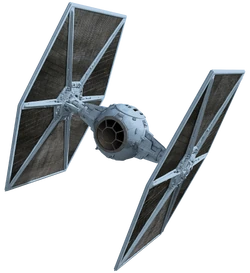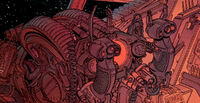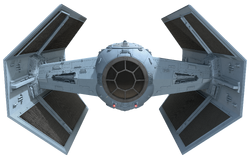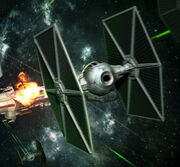m (Fixing trailing text) Tag: apiedit |
m (Cleanup source/reference formatting) |
||
| (22 intermediate revisions by 10 users not shown) | |||
| Line 1: | Line 1: | ||
{{Eras|imp|reb|new|njo|leg|sprot|canon=TIE line}} |
{{Eras|imp|reb|new|njo|leg|sprot|canon=TIE line}} |
||
| − | [[File:TIEfighter-Fathead.png|right|thumb|250px|A [[ |
+ | [[File:TIEfighter-Fathead.png|right|thumb|250px|A [[TIE/LN starfighter]]]] |
The '''TIE Series''' was a series of [[Starfighter/Legends|starfighters]] and vehicles designed by [[Sienar Fleet Systems/Legends|Sienar Fleet Systems]]. |
The '''TIE Series''' was a series of [[Starfighter/Legends|starfighters]] and vehicles designed by [[Sienar Fleet Systems/Legends|Sienar Fleet Systems]]. |
||
| Line 6: | Line 6: | ||
===Design=== |
===Design=== |
||
[[File:TieInterior.jpg|thumb|left|200px|Interior of a [[Twin ion engine/Legends|TIE]] series [[Starfighter/Legends|starfighter]].]] |
[[File:TieInterior.jpg|thumb|left|200px|Interior of a [[Twin ion engine/Legends|TIE]] series [[Starfighter/Legends|starfighter]].]] |
||
| − | TIE series starfighters shared a general design form of a roughly spherical or cylindrical cockpit pod attached to a set of solar panels, with their overall shape resembling a bow tie apparel (thus acting as a partial namesake).<ref name="Rogue Leader guide">''[[Star Wars: Rogue Squadron II: Rogue Leader]]''</ref> The cockpit and panels could be supplemented by other modules for ordnance or other functions. Their overall design bore a large resemblance to the [[Human/Legends|Human]] eye, which led to several members of the Rebel Alliance, including those of [[Rogue Squadron/Legends|Rogue Squadron]], to give them nicknames relating to eyes (such as "eyeball" for [[TIE/LN starfighter |
+ | TIE series starfighters shared a general design form of a roughly spherical or cylindrical cockpit pod attached to a set of solar panels, with their overall shape resembling a bow tie apparel (thus acting as a partial namesake).<ref name="Rogue Leader guide">''[[Star Wars: Rogue Squadron II: Rogue Leader]]''</ref> The cockpit and panels could be supplemented by other modules for ordnance or other functions. Their overall design bore a large resemblance to the [[Human/Legends|Human]] eye, which led to several members of the Rebel Alliance, including those of [[Rogue Squadron/Legends|Rogue Squadron]], to give them nicknames relating to eyes (such as "eyeball" for [[TIE/LN starfighter]]s, "squints" for [[TIE/IN interceptor/Legends|TIE/IN interceptors]], "dupes" for [[TIE/sa bomber/Legends|TIE/sa bombers]], and "brights" for the [[TIE Advanced x1/Legends|TIE Advanced]] series of starfighters, respectively).{{Fact}} |
This design form carried over to the non-starfighter products, with the standard cockpit module used in the center of a land or sea vessel. |
This design form carried over to the non-starfighter products, with the standard cockpit module used in the center of a land or sea vessel. |
||
The cockpit of a TIE was neither spacious nor luxurious, even when compared to other starfighters. A TIE fighter was designed with the bare minimum a ship needed to function, being essentially nothing more than a cockpit with weapons on the front and an engine in the rear. This simplicity in design made them both quick and inexpensive to build and replace. |
The cockpit of a TIE was neither spacious nor luxurious, even when compared to other starfighters. A TIE fighter was designed with the bare minimum a ship needed to function, being essentially nothing more than a cockpit with weapons on the front and an engine in the rear. This simplicity in design made them both quick and inexpensive to build and replace. |
||
| − | |||
| − | The TIE Series also had a distinct sound that is heard when flying, sounding like roaring. |
||
===Technology=== |
===Technology=== |
||
| ⚫ | |||
| − | The TIE series derived its name from the [[SIE-TIE twin ion engine|SIE-TIE]] [[Twin ion engine/Legends|twin ion engine]], which was unveiled to the public by [[Raith Sienar/Legends|Raith Sienar]] in [[22 BBY]]. [[T.I.E. starfighter|Prototypes]] of TIE series starfighters may have been tested as early as [[29 BBY]]. |
+ | The TIE series derived its name from the [[SIE-TIE twin ion engine|SIE-TIE]] [[Twin ion engine/Legends|twin ion engine]], which was unveiled to the public by [[Raith Sienar/Legends|Raith Sienar]] in [[22 BBY/Legends|22 BBY]]. [[T.I.E. starfighter|Prototypes]] of TIE series starfighters may have been tested as early as [[29 BBY/Legends|29 BBY]]. TIE fighters were used on Imperial [[Victory-class Star Destroyer/Legends|''Victory''-class Star Destroyers]], such as the [[Strikefast/Legends|''Strikefast'']] as early as [[19 BBY/Legends|19 BBY]], one week after the Empire was formed. At first, the launching systems often suffered from failures, and had to undergo several redesigns. Because of the nature of their engines, the TIE series also had a distinct sound uttered whenever they flew about. |
All TIE series starfighters had two or more [[Ion drive|ion engine]] outlets, linked to a solar ionization reactor and solar array wings. |
All TIE series starfighters had two or more [[Ion drive|ion engine]] outlets, linked to a solar ionization reactor and solar array wings. |
||
| Line 22: | Line 21: | ||
===Combat capabilities=== |
===Combat capabilities=== |
||
| − | [[File:TIE Fighter SWGTCG.jpg| |
+ | [[File:TIE Fighter SWGTCG.jpg|left|thumb|180px|[[TIE/LN starfighter|TIE fighters]] disabling a [[CR90 corvette/Legends|CR90 corvette]].]] |
| − | Ships in the TIE series were usually armed with one or more [[Laser cannon/Legends|laser cannons]]. More advanced fighters were equipped with a variety of warhead launchers, and the [[TIE/ad starfighter|TIE Avenger]] and [[TIE/D Defender/Legends|TIE Defender]] could be fitted with a small-scale [[Tractor beam/Legends|tractor beam]]. |
+ | Ships in the TIE series were usually armed with one or more [[Laser cannon/Legends|laser cannons]], two being the standard. More advanced fighters were equipped with a variety of warhead launchers, and the [[TIE/ad starfighter|TIE Avenger]] and [[TIE/D Defender/Legends|TIE Defender]] could be fitted with a small-scale [[Tractor beam/Legends|tractor beam]]. |
Very few TIE starfighters were equipped with combat [[Deflector shield/Legends|shielding]], though they were included on the Avenger and Defender and could be retrofitted onto most TIE types. This lack of shielding was a factor toward the TIEs extreme speed. Retrofitting of this type was fairly common in the [[New Republic/Legends|New Republic]] era, as ships and manpower became more valuable to [[Galactic Empire/Legends|Imperial]] forces. |
Very few TIE starfighters were equipped with combat [[Deflector shield/Legends|shielding]], though they were included on the Avenger and Defender and could be retrofitted onto most TIE types. This lack of shielding was a factor toward the TIEs extreme speed. Retrofitting of this type was fairly common in the [[New Republic/Legends|New Republic]] era, as ships and manpower became more valuable to [[Galactic Empire/Legends|Imperial]] forces. |
||
| Line 32: | Line 31: | ||
==Behind the scenes== |
==Behind the scenes== |
||
| ⚫ | |||
Though the term "TIE Fighter" was coined because [[George Lucas]] thought they looked like bow ties, the [[Wikipedia:Ion engine|ion engine]] is a real-life type of spacecraft propulsion, and publicity surrounding the launch of the [http://www.esa.int/SPECIALS/SMART-1/ SMART-1] spacecraft, particularly the shuttle [http://www.space.com/businesstechnology/technology/technovel Smart-1], likened its ion thruster to the propulsion systems of a TIE Fighter. Taking this comparison further, a number of canon sources describe the large vertical wings of a TIE as something like the [[Wikipedia:Solar panel#Solar panels on spacecraft|photovoltaic solar panels]] typically used to power real-life ion-drives: terms like "solar arrays" or "solar gather panels" are used to describe the TIEs' wings, and it is explicitly said that they draw on the energy of starlight and play at least a partial role in powering the engines. |
Though the term "TIE Fighter" was coined because [[George Lucas]] thought they looked like bow ties, the [[Wikipedia:Ion engine|ion engine]] is a real-life type of spacecraft propulsion, and publicity surrounding the launch of the [http://www.esa.int/SPECIALS/SMART-1/ SMART-1] spacecraft, particularly the shuttle [http://www.space.com/businesstechnology/technology/technovel Smart-1], likened its ion thruster to the propulsion systems of a TIE Fighter. Taking this comparison further, a number of canon sources describe the large vertical wings of a TIE as something like the [[Wikipedia:Solar panel#Solar panels on spacecraft|photovoltaic solar panels]] typically used to power real-life ion-drives: terms like "solar arrays" or "solar gather panels" are used to describe the TIEs' wings, and it is explicitly said that they draw on the energy of starlight and play at least a partial role in powering the engines. |
||
| − | Many fans have disagreed with this information, on the grounds that the power output of solar panels would not be sufficient to give TIEs the acceleration attributed to them, particularly given that TIEs have never been indicated to suffer reduced performance in interstellar space or when flying at night on a planet. Some seek to discard the "solar panel" idea altogether, and the wings of the [[Prequel trilogy|prequel]]-era forerunners of the TIE, |
+ | Many fans have disagreed with this information, on the grounds that the power output of solar panels would not be sufficient to give TIEs the acceleration attributed to them, particularly given that TIEs have never been indicated to suffer reduced performance in interstellar space or when flying at night on a planet. Some seek to discard the "solar panel" idea altogether, and the wings of the [[Prequel trilogy|prequel]]-era forerunners of the TIE, [[Scimitar/Legends|''Scimitar'']] and Advanced Projects prototype, have been identified instead as radiator assemblages for waste heat from a conventional Star Wars reactor core. |
Other fans are reluctant to dismiss any [[canon]] material, offering the alternative explanation that mass-lightening technology (which should be possible with the mastery of artificial gravity, repulsorlift devices, inertial compensators and gravity-well generators in the [[The galaxy/Legends|GFFA]]) may make such low-powered drives practicable, and suggesting that if the wings of production-model TIEs retain a radiator function, this operates alongside their primary role as solar arrays. |
Other fans are reluctant to dismiss any [[canon]] material, offering the alternative explanation that mass-lightening technology (which should be possible with the mastery of artificial gravity, repulsorlift devices, inertial compensators and gravity-well generators in the [[The galaxy/Legends|GFFA]]) may make such low-powered drives practicable, and suggesting that if the wings of production-model TIEs retain a radiator function, this operates alongside their primary role as solar arrays. |
||
| Line 43: | Line 41: | ||
Another issue that is widely questioned is the lack of shielding on TIE fighters, as it is felt that all TIE series starfighters must at least have some form of shielding against space debris. The most common explanation (and probably most logical) is that while all fighters have particle shields, most were not equipped with energy shields. |
Another issue that is widely questioned is the lack of shielding on TIE fighters, as it is felt that all TIE series starfighters must at least have some form of shielding against space debris. The most common explanation (and probably most logical) is that while all fighters have particle shields, most were not equipped with energy shields. |
||
| − | The TIE series' trademark roaring sounds when undergoing flight were derived from mixing an elephant's screams with a car driving on a wet road. |
+ | The TIE series' trademark roaring sounds when undergoing flight were derived from mixing an elephant's screams with a car driving on a wet road. The sound was also created by accident: Ben Burtt was initially tasked with creating a sound similar to those of Nazi rockets in a BBC documentary of the Battle of Stalingrad that George Lucas had watched earlier, and resorted to drawing out an elephant's cry from the 1958 film ''The Roots of Heaven'' and then doing the aforementioned mixture. Joe Johnston also noted that it sounded similar to the Nazis' Junker JU-87 dive planes.<ref name="USO Project">http://usoproject.blogspot.co.uk/2011/02/ben-burtt-about-genesis-of-tie-fighter.html</ref> |
==Appearances== |
==Appearances== |
||
| Line 52: | Line 50: | ||
*''[[Star Wars: Jedi Starfighter]]'' {{Nc}} |
*''[[Star Wars: Jedi Starfighter]]'' {{Nc}} |
||
*''[[Star Wars: Battlefront II]]'' |
*''[[Star Wars: Battlefront II]]'' |
||
| − | * |
+ | *[[LEGO Star Wars: The Quest for R2-D2 (film)|''LEGO Star Wars: The Quest for R2-D2'']] {{Nc}} |
*''[[Star Wars Battlefront: Elite Squadron]]'' |
*''[[Star Wars Battlefront: Elite Squadron]]'' |
||
*''[[The Last of the Jedi: Reckoning]]'' |
*''[[The Last of the Jedi: Reckoning]]'' |
||
| Line 64: | Line 62: | ||
*''[[Star Wars Galaxies]]'' |
*''[[Star Wars Galaxies]]'' |
||
*''[[Mission to Lianna]]'' {{C|As "TIE-series"}} |
*''[[Mission to Lianna]]'' {{C|As "TIE-series"}} |
||
| + | *{{Journal|10|Galaxywide NewsNets}} |
||
*{{FFG|book=Strongholds of Resistance|story=Phantoms in the Dark}} |
*{{FFG|book=Strongholds of Resistance|story=Phantoms in the Dark}} |
||
*[[Star Wars Episode V: The Empire Strikes Back (junior novelization)|''Star Wars Episode V: The Empire Strikes Back'' junior novel]] |
*[[Star Wars Episode V: The Empire Strikes Back (junior novelization)|''Star Wars Episode V: The Empire Strikes Back'' junior novel]] |
||
| Line 91: | Line 90: | ||
*''[[Star Wars Campaign Pack]]'' |
*''[[Star Wars Campaign Pack]]'' |
||
*''[[Imperial Sourcebook]]'' |
*''[[Imperial Sourcebook]]'' |
||
| − | *''[[Rebel Alliance Sourcebook]]'' |
+ | *''[[The Rebel Alliance Sourcebook]]'' |
*''[[Galaxy Guide 8: Scouts]]'' |
*''[[Galaxy Guide 8: Scouts]]'' |
||
| − | *[[Rebel Alliance Sourcebook (Second Edition)|''Rebel Alliance Sourcebook'', Second Edition]] |
+ | *[[The Rebel Alliance Sourcebook (Second Edition)|''The Rebel Alliance Sourcebook'', Second Edition]] |
*[[Star Wars Sourcebook (Second Edition)|''Star Wars Sourcebook'', Second Edition]] |
*[[Star Wars Sourcebook (Second Edition)|''Star Wars Sourcebook'', Second Edition]] |
||
| + | *''[[Alliance Intelligence Reports]]'' |
||
*{{Journal|10|Alliance Intelligence Report: TIE Fighters}} |
*{{Journal|10|Alliance Intelligence Report: TIE Fighters}} |
||
*[[Star Wars Customizable Card Game|''Star Wars'' Customizable Card Game]] |
*[[Star Wars Customizable Card Game|''Star Wars'' Customizable Card Game]] |
||
| + | *''[[Star Wars: X-Wing Alliance: Prima's Official Strategy Guide]]'' |
||
| − | *{{Hnn|51|business/13411_1.html|Successful Engine Tests Cause Sienar Stock Surge}} |
+ | *{{Hnn|51|business/13411_1.html|Successful Engine Tests Cause Sienar Stock Surge|https://web.archive.org/web/20130728124624/http://www.holonetnews.com/51/business/13411_1.html}} |
*''[[The New Essential Guide to Vehicles and Vessels]]'' |
*''[[The New Essential Guide to Vehicles and Vessels]]'' |
||
| − | * |
+ | *[[Star Wars: Age of Rebellion Core Rulebook|''Star Wars: Age of Rebellion'' Core Rulebook]] {{1stID}} |
*<!-- 2014/10/20 -->''[[Star Wars: Imperial Handbook: A Commander's Guide]]'' |
*<!-- 2014/10/20 -->''[[Star Wars: Imperial Handbook: A Commander's Guide]]'' |
||
*''[[Lords of Nal Hutta]]'' |
*''[[Lords of Nal Hutta]]'' |
||
| Line 107: | Line 108: | ||
*{{WP|TIE fighter}} |
*{{WP|TIE fighter}} |
||
*[http://theforce.net/swtc/tie.html TIE Fighters] at [[Curtis Saxton]]'s [[Star Wars Technical Commentaries]] |
*[http://theforce.net/swtc/tie.html TIE Fighters] at [[Curtis Saxton]]'s [[Star Wars Technical Commentaries]] |
||
| + | |||
| + | ==Notes and references== |
||
| + | {{Reflist}} |
||
{{More sources}} |
{{More sources}} |
||
| Line 116: | Line 120: | ||
|de=TIE-Serie |
|de=TIE-Serie |
||
|es=Serie TIE |
|es=Serie TIE |
||
| − | |pl=TIE |
+ | |pl=TIE/Legendy |
|fi=TIE-sarja |
|fi=TIE-sarja |
||
|ru=Серия TIE |
|ru=Серия TIE |
||
Revision as of 04:13, 21 October 2019
| | |

The TIE Series was a series of starfighters and vehicles designed by Sienar Fleet Systems.
Characteristics
Design

Interior of a TIE series starfighter.
TIE series starfighters shared a general design form of a roughly spherical or cylindrical cockpit pod attached to a set of solar panels, with their overall shape resembling a bow tie apparel (thus acting as a partial namesake).[1] The cockpit and panels could be supplemented by other modules for ordnance or other functions. Their overall design bore a large resemblance to the Human eye, which led to several members of the Rebel Alliance, including those of Rogue Squadron, to give them nicknames relating to eyes (such as "eyeball" for TIE/LN starfighters, "squints" for TIE/IN interceptors, "dupes" for TIE/sa bombers, and "brights" for the TIE Advanced series of starfighters, respectively).[source?]
This design form carried over to the non-starfighter products, with the standard cockpit module used in the center of a land or sea vessel.
The cockpit of a TIE was neither spacious nor luxurious, even when compared to other starfighters. A TIE fighter was designed with the bare minimum a ship needed to function, being essentially nothing more than a cockpit with weapons on the front and an engine in the rear. This simplicity in design made them both quick and inexpensive to build and replace.
Technology

The TIE series derived its name from the SIE-TIE twin ion engine, which was unveiled to the public by Raith Sienar in 22 BBY. Prototypes of TIE series starfighters may have been tested as early as 29 BBY. TIE fighters were used on Imperial Victory-class Star Destroyers, such as the Strikefast as early as 19 BBY, one week after the Empire was formed. At first, the launching systems often suffered from failures, and had to undergo several redesigns. Because of the nature of their engines, the TIE series also had a distinct sound uttered whenever they flew about.
All TIE series starfighters had two or more ion engine outlets, linked to a solar ionization reactor and solar array wings.
Except for advanced models, TIE series vessels were not generally equipped with hyperdrives, but they could be added as an option. Early TIE models tended to suffer noticeably in sublight performance if given this upgrade, due to the added mass of the hyperdrive and navicomputer systems. Apparently not all TIEs were equipped with a missile lock warning sensor to warn a pilot of an enemy missile lock, though many were.
Combat capabilities

TIE fighters disabling a CR90 corvette.
Ships in the TIE series were usually armed with one or more laser cannons, two being the standard. More advanced fighters were equipped with a variety of warhead launchers, and the TIE Avenger and TIE Defender could be fitted with a small-scale tractor beam.
Very few TIE starfighters were equipped with combat shielding, though they were included on the Avenger and Defender and could be retrofitted onto most TIE types. This lack of shielding was a factor toward the TIEs extreme speed. Retrofitting of this type was fairly common in the New Republic era, as ships and manpower became more valuable to Imperial forces.
In 40 ABY, during the start of the Second Galactic Civil War, the Aleph-class starfighter was produced by Sienar for the Galactic Alliance's Navy. Like its predecessors, the Aleph had a ball-shaped cockpit pod which was larger than that of a standard TIE variant. However, it was designed as a two-seater complete with an astromech droid socket and more weapons.
The Galactic Empire continued to utilize TIE designs, such as the Predator-class fighter used around 130 ABY.
Behind the scenes
Though the term "TIE Fighter" was coined because George Lucas thought they looked like bow ties, the ion engine is a real-life type of spacecraft propulsion, and publicity surrounding the launch of the SMART-1 spacecraft, particularly the shuttle Smart-1, likened its ion thruster to the propulsion systems of a TIE Fighter. Taking this comparison further, a number of canon sources describe the large vertical wings of a TIE as something like the photovoltaic solar panels typically used to power real-life ion-drives: terms like "solar arrays" or "solar gather panels" are used to describe the TIEs' wings, and it is explicitly said that they draw on the energy of starlight and play at least a partial role in powering the engines.
Many fans have disagreed with this information, on the grounds that the power output of solar panels would not be sufficient to give TIEs the acceleration attributed to them, particularly given that TIEs have never been indicated to suffer reduced performance in interstellar space or when flying at night on a planet. Some seek to discard the "solar panel" idea altogether, and the wings of the prequel-era forerunners of the TIE, Scimitar and Advanced Projects prototype, have been identified instead as radiator assemblages for waste heat from a conventional Star Wars reactor core.
Other fans are reluctant to dismiss any canon material, offering the alternative explanation that mass-lightening technology (which should be possible with the mastery of artificial gravity, repulsorlift devices, inertial compensators and gravity-well generators in the GFFA) may make such low-powered drives practicable, and suggesting that if the wings of production-model TIEs retain a radiator function, this operates alongside their primary role as solar arrays.
Yet other fans prefer different ideas—for instance, the theory that the small nozzles at the back of the cockpit are simply heat exhausts, and the wing panels are themselves some sort of particle thrusters, with thrust in different directions from different sections giving them their incredible maneuverability.
Another issue that is widely questioned is the lack of shielding on TIE fighters, as it is felt that all TIE series starfighters must at least have some form of shielding against space debris. The most common explanation (and probably most logical) is that while all fighters have particle shields, most were not equipped with energy shields.
The TIE series' trademark roaring sounds when undergoing flight were derived from mixing an elephant's screams with a car driving on a wet road. The sound was also created by accident: Ben Burtt was initially tasked with creating a sound similar to those of Nazi rockets in a BBC documentary of the Battle of Stalingrad that George Lucas had watched earlier, and resorted to drawing out an elephant's cry from the 1958 film The Roots of Heaven and then doing the aforementioned mixture. Joe Johnston also noted that it sounded similar to the Nazis' Junker JU-87 dive planes.[2]
Appearances
Sources
- Star Warriors: Starfighter Combat in the Star Wars Universe
- The Star Wars Sourcebook
- Star Wars Campaign Pack
- Imperial Sourcebook
- The Rebel Alliance Sourcebook
- Galaxy Guide 8: Scouts
- The Rebel Alliance Sourcebook, Second Edition
- Star Wars Sourcebook, Second Edition
- Alliance Intelligence Reports
 "Alliance Intelligence Report: TIE Fighters" — Star Wars Adventure Journal 10
"Alliance Intelligence Report: TIE Fighters" — Star Wars Adventure Journal 10- Star Wars Customizable Card Game
- Star Wars: X-Wing Alliance: Prima's Official Strategy Guide
 Successful Engine Tests Cause Sienar Stock Surge — HoloNet News Vol. 531 #51 (content now obsolete; backup link)
Successful Engine Tests Cause Sienar Stock Surge — HoloNet News Vol. 531 #51 (content now obsolete; backup link)- The New Essential Guide to Vehicles and Vessels
- Star Wars: Age of Rebellion Core Rulebook (First identified as TIE Series)
- Star Wars: Imperial Handbook: A Commander's Guide
- Lords of Nal Hutta
- Fly Casual
